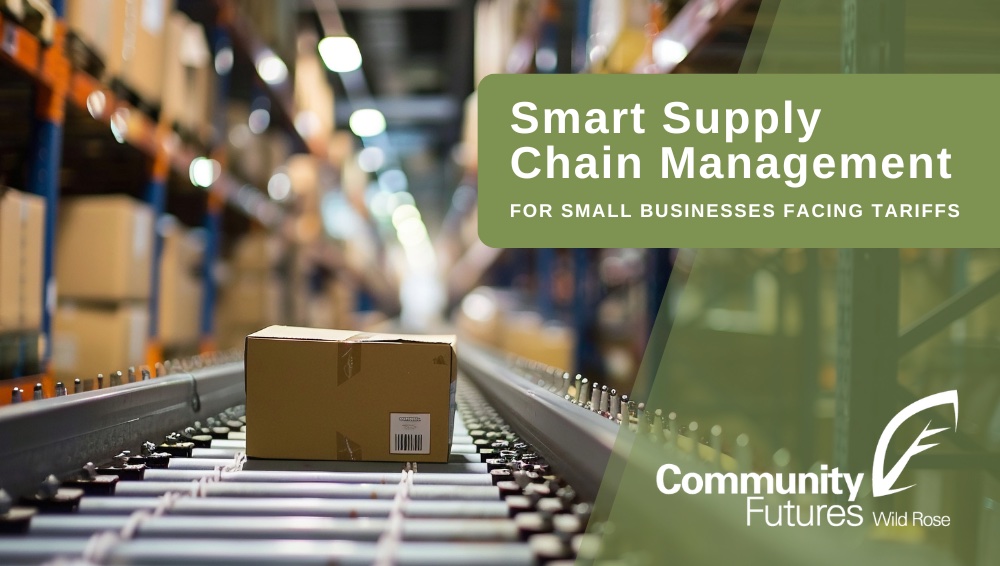For small business owners, understanding and managing a supply chain is vital to the success and sustainability of their operations. A supply chain is the network of people and organizations involved in creating and delivering a product, from raw material suppliers to manufacturers, warehousing, transportation companies, and retailers.
Effective supply chain management (SCM) helps businesses keep costs down, maintain quality, and ensure timely delivery. By optimizing these processes, you can reduce waste and improve your competitive edge in the market. However, when one part of the chain is disrupted (whether by delays, shortages, or economic challenges), it can lead to significant setbacks for your business. One such challenge, currently affecting businesses here in Alberta and across Canada, is the rise of tariffs and their impact on supply chains.
The Impact of Tariffs on Supply Chains
Tariffs, taxes imposed on goods and services as they cross national borders, are increasingly becoming a critical issue for small businesses engaged in international trade. There are two main types of tariffs: import tariffs, which apply to goods entering a country, and export tariffs, which are levied on goods leaving a country. These tariffs can be fixed (set fees per unit) or variable (based on the value of the goods). Governments implement tariffs for various reasons, including generating revenue, protecting domestic industries, or advancing national interests through foreign policy.
Recently, the U.S. imposed tariffs on Canadian goods, including a 25% tariff on Canadian steel and aluminum and a 25% tariff on Canadian automobiles. In response, Canada retaliated with its own tariffs on U.S. goods. This back-and-forth has created significant uncertainty for businesses reliant on cross-border supply chains, as materials and components often cross this border multiple times. Each time goods cross a border, tariffs are applied, driving up costs for businesses on both sides. These rising costs impact everything from raw material sourcing to the prices consumers pay for products.
For small businesses, managing this disruption requires strategic planning, such as diversifying suppliers and strengthening supply chain management practices to remain competitive and mitigate tariff risks.
To help businesses navigate these challenges, the Canadian government offers a range of support programs designed to assist those directly impacted by U.S. tariffs. These resources aim to help businesses manage disruptions, adapt their operations, and explore new opportunities for growth both at home and abroad. You can find more information, available resources, and business support at international.canada.ca.
Current Tariff Timeline
To understand the ongoing impact of tariffs on supply chains, it's important to keep track of the key events in the current tariff dispute between the U.S. and Canada:
- January 20, 2025: U.S. President Trump signs an executive order announcing the imposition of 25% tariffs on Canadian and Mexican goods, set to take effect February 1, 2025.
- February 1, 2025: U.S. tariffs of 25% are imposed on Canadian imports, with a lower 10% levy on Canadian energy imports. Canada announces retaliatory tariffs on $30 billion worth of U.S. goods to go into effect immediately.
- February 2, 2025: Canada introduces further tariffs on U.S. goods, including additional measures to support affected businesses.
- February 3, 2025: A 30-day pause is agreed upon between Canada and the U.S., allowing for potential negotiations to address the situation.
- March 4, 2025: The U.S. proceeds with imposing 25% tariffs on Canadian exports and 10% tariffs on Canadian energy exports.
- March 12, 2025: The U.S. extends tariffs of 25% to Canadian steel and aluminum products.
- April 3, 2025: A 25% tariff is placed on Canadian automobiles.
How Small Businesses Can Strengthen Their Supply Chain Strategy
In recent years, small businesses have been asked to pivot constantly. From the impacts of COVID-19 to ongoing supply chain disruptions, rising costs of goods, and now the imposition of new tariffs, entrepreneurs are under pressure to be more resilient than ever. Navigating these challenges requires a thoughtful and forward-looking approach to supply chain management. The strategies below can help your business remain competitive, minimize disruptions, and uncover new opportunities for growth.
1. Understand the Tariff Impact
Start by assessing how new tariffs affect your business. Determine what percentage is being applied, which components or raw materials are affected, and how this changes your cost structure. This clarity will help you make better sourcing, pricing, and inventory decisions.
2. Diversify Suppliers and Partners
One of the most critical actions small businesses can take is to diversify their supply chains. Tariffs and trade disruptions highlight the risks of relying on a single supplier or country for key materials. Strengthen your network by sourcing from multiple regions or developing local alternatives where possible. Consider joint ventures or partnerships to expand your access to new markets and materials.
3. Optimize Procurement and Inventory Management
In addition, it’s crucial to optimize your supply chain to better absorb the impact of tariffs. Reevaluate your procurement process to identify inefficiencies. Smart inventory practices (like maintaining safety stock for high-risk items) can reduce the impact of delivery delays or price spikes. Balance lean practices with enough buffer to withstand shocks.
4. Invest in Technology
Investing in technology enablement is an excellent way to future-proof your supply chain. Use digital tools that offer real-time tracking, data analytics, and supply chain visibility. Even small investments in inventory or shipping management software can help you react quickly to changes and forecast more accurately.
5. Network and Communicate Clearly
Supply chain growth is about operations, but also about visibility and relationships. Attend industry events, trade shows, and forums to meet potential collaborators and decision-makers. Ensure your messaging is consistent across your website, social media, and printed materials. And don’t forget internal communication, as your employees are often your best ambassadors.
Final Thoughts
Tariffs are just one of many challenges today’s small businesses face. A proactive and strategic approach to supply chain management can help reduce their impact and uncover new paths for growth. By diversifying your suppliers, streamlining procurement, and leveraging technology, your business can better navigate uncertainty, manage costs, and stay competitive. Ultimately, building a resilient supply chain means more than just getting through tough times, it positions your business to thrive in a rapidly changing global market.
Further Reading:
- Supply Chain Overview – Investopedia
- Supply Chain Management – Investopedia
- Canada's Response to U.S. Tariffs
- Support for Canadian Businesses and Workers Amid Tariffs
- Tariff Exposure Risk Assessment – MNP
- Managing the Impact of Potential Tariffs on Your Supply Chain – BDC
- How to Improve Resilience and Diversify Your Supply Chain – BDC
- Federal and Provincial Tariff Support Programs – MNP
- How Tariffs Work for Business – EDC
- Supply Chain Transformation: Key Areas to Examine – MNP




